
The Maryhill Stained Glass Panels by Stephen Adam
Explore the famous stained glass panels made in 1878 by Adam & Small for the newly opened Maryhill Burgh Halls. It’s a series of 20 unique panels representing the trades and industries of Maryhill in the late 19th century.
Download a free PDF booklet about the Adam stained glass
Maryhill Burgh Halls contained twenty stained glass panels created by the studio of Adam and Small. This studio was set up in Glasgow by Stephen Adam in 1870 and the company produced possibly the most significant examples of Scottish stained glass for the next four decades, until Adam's death in 1910. The contribution of Adam's work at that time cannot be underestimated. He is recognised as an internationally important artist in the field of stained glass design and production.
Stephen Adam was born near Edinburgh in 1847 and in 1862 was apprenticed to James Ballantine of Edinburgh, at that time the leading firm working in stained glass in Scotland. They were the leading company in the revival of the craft in Scotland in the latter half of the 19th century.
The realism of the portrayals of the industries and trades in the Maryhill Windows is in marked contrast to Adam’s other stained glass treatments of similar subjects. His windows for Glasgow City Chambers (1882-90) include depictions of workmen, but these are portrayed in classical clothing and poses: at Aberdeen Trinity Hall (1893), the figures are shown in Biblical and medieval settings; and at the Clyde Navigation Trust Building (1905-08) the industries are represented by classical nymphs or goddesses and the workmen and traders at the docks in late-medieval/Renaissance clothes.
Only at Maryhill were real people depicted as they really were, in their everyday working clothes.
The stained glass was removed from the building in 1963, and has been in the care of Glasgow Museums ever since. The refurbishment and re-opening of the building in 2012 has allowed 11 of the original panels to be returned to their original location in the Main Hall for display, alongside ten modern Windows of Today.
<< back to our stained glass
The Dye-press Worker
The process shown in this panel had long been a mystery, finally being solved by author Michael Meighan, who had been researching for his new book ‘Glaswegians with a Flourish’.
He came across the Institute’s ‘Mechanics Magazine’ published in 1824 and held by the National Library of Scotland. On the front page of one of the issues was a drawing of a press almost exactly like the equipment being used in the stained glass window.
Imagine my growing interest as I started reading a ‘Description of the Great Bandana Gallery in the Turkey Red factory of Messrs Monteith & Co. at Glasgow’. Turkey red dyeing was originally brought to Scotland from France, and became a massively important industry in the West of Scotland in the 1800’s. Cowboy bandanas, and beautifully patterned cloths were exported throughout the world. The dyeing process was revolutionary as it allowed whole cloths to be dyed, rather than the threads from which they were made, shortening the process considerably.
But just as one puzzle is solved, it also reveals more questions to be asked – we don’t know which company in the Maryhill area might have been using this process at the time the panels were commissioned – so there’s still more to find out...
The Zinc Spelters
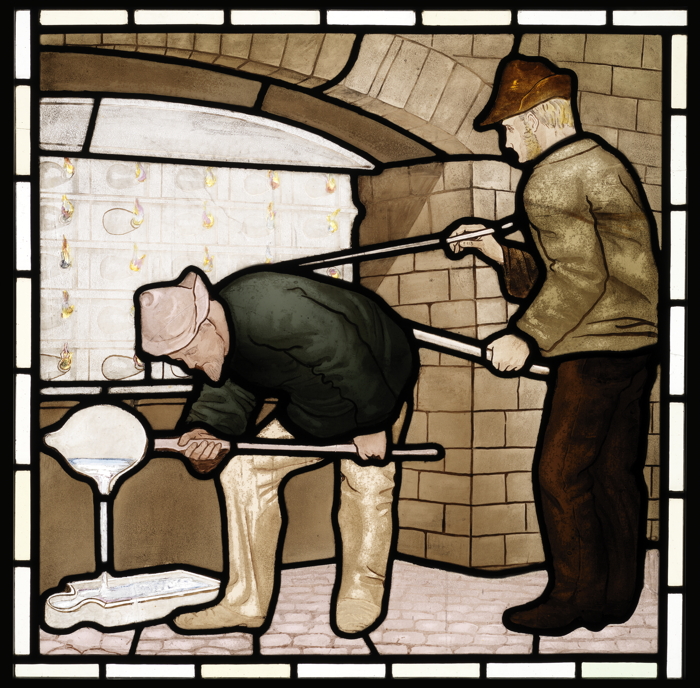
The Wheelwrights
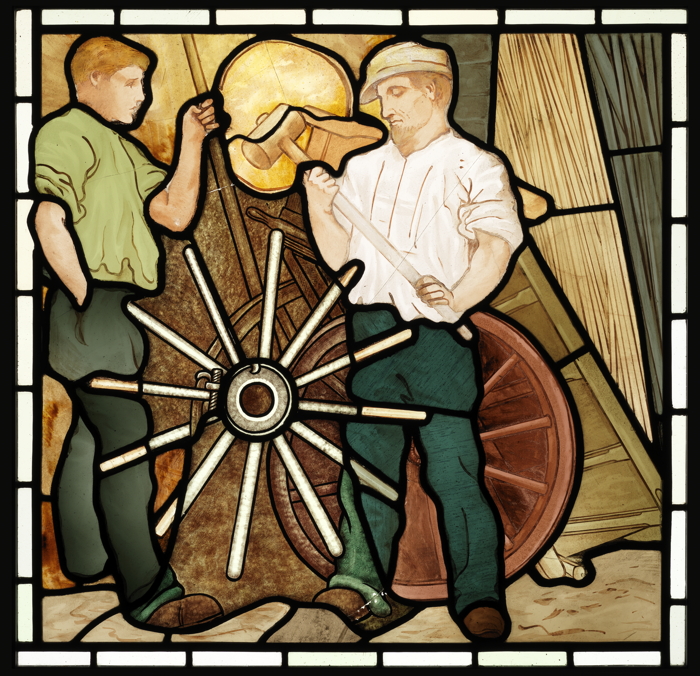
Working with wooden tools, they are making wooden wheels. In 1878, most vehicles, carts & carriages still had wooden wheels, though these were iron-girded. A coachbuilder’s shop appears likely, and at Ruchill Bridge was located David Stirrat & Co., spring van and lorry builders, which fits the bill.
In 1900 this building became a cooperage for Fergusson’s lead and paint works. It occupied the now waste ground north of Ruchill Church.
The Teacher

The Education Act of 1872 in theory made primary education compulsory, and this looks like one of Maryhill’s first primary teachers. According to A Thomson’s Maryhill (1895) there were three primaries – Maryhill Public School, East Park Public School, and Church Street Public School, one of which is illustrated above.
The map, interestingly, shows England. It is possible that the teacher was John Russell, parish teacher and session clerk. The Glasgow Post Office Directory for 1877-8, however, gives another Public School teacher, a James A Miller. Although education was free, parents had to pay towards the cost of books. Note the children’s tackety boots.
The Soldiers
Newly opened in 1876 when Adam completed this panel, the Maryhill Barracks were used by various regiments until eventually becoming associated with the Highland Light Infantry or H.L.I. Soldiers then, like policemen, all wore mustaches.
The building where the two soldiers are shown could well be the still extant gatehouse, looking out onto the tenements on Maryhill Road, or more likely inwards to the barracks themselves. Note the pan-tiled, rather than slated roofs, which was quite common at the time.
Along with the gatehouse, the barracks wall remains, along with the iron bollards embossed with VR (Victoria Regina), as seen in the Canteen sign in the panel.
The Sawyer
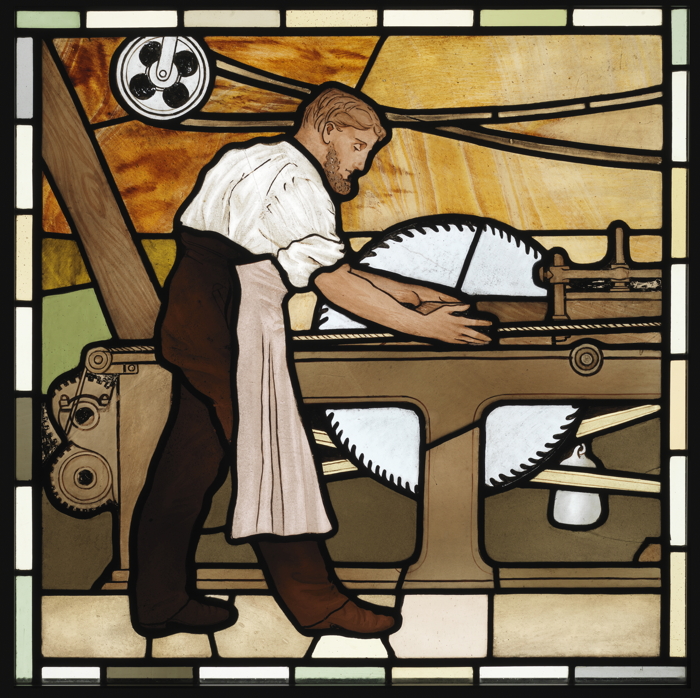
Firhill Sawmills in Murano Street and MacFarlane’s Ruchill Sawmills in Shuna Street were both operating in 1878. The man shown might be working at either, or at the Western Sawmills at Firhill Timber Basin, built with the canal but greatly extended from 1848.
Ruchill Sawmills became part of Bryant and May’s match factory c.1918, and the Firhill Sawmills were the last to go in 1969.
The Railwaymen
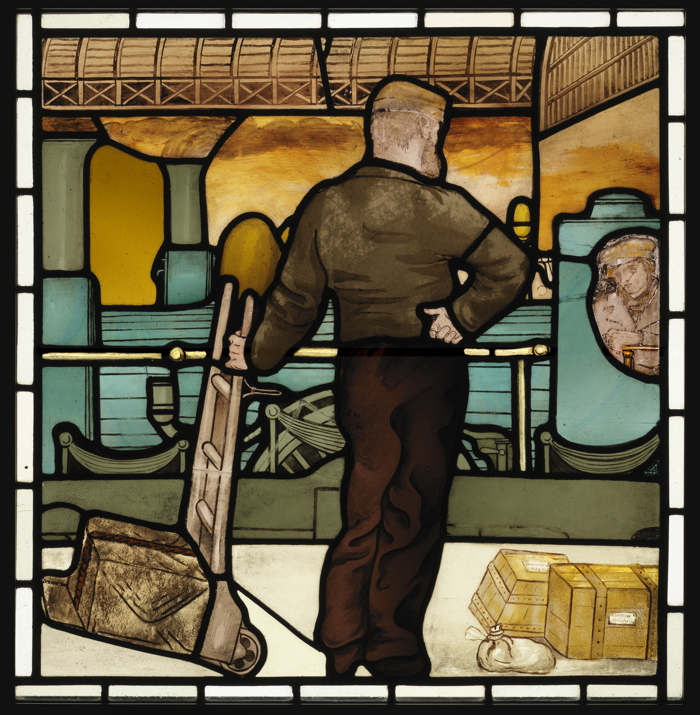
Maryhill had two stations: Maryhill Central Station for the Lanarkshire and Dumbartonshire Railway was built in 1896, and demolished in 1966. The station shown is thus likely to be Maryhill Park Station, at Station Road.
This was constructed in 1858 for the Glasgow, Dumbarton and Helensburgh Railway. Closed, the station was reopened in the 1990s. This was originally a goods, as well as a passenger station, shown by the parcels carried by the porter.
Examination of the crates on the platform show that they are addressed ‘Newcastle-Maryhill’ and ‘London-Maryhill’ The sack beside them is addressed for one ‘James Black, Paisley’.
The Papermaker
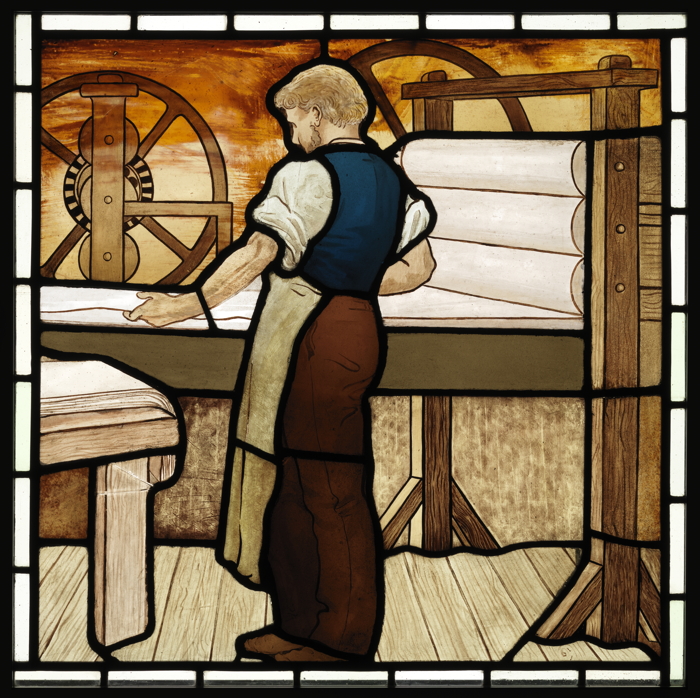
Unlike other industries which moved to the canal with steam power, the paper mills stayed on the River Kelvin, because of their need for large amounts of water. The man here is either working at the Dalsholm Paper Mills, founded by William MacArthur in 1783 on Dalsholm Road near Dalsholm Bridge, or at the Kelvindale Mills further downriver at Kelvindale Road, established at about the same time as a snuff mill and later converted to paper making.
This latter works’ lade and weir are still visible on the Kelvin. Dalsholm closed in the 1970s, Kelvindale had shut down earlier.
The Linen Bleachers
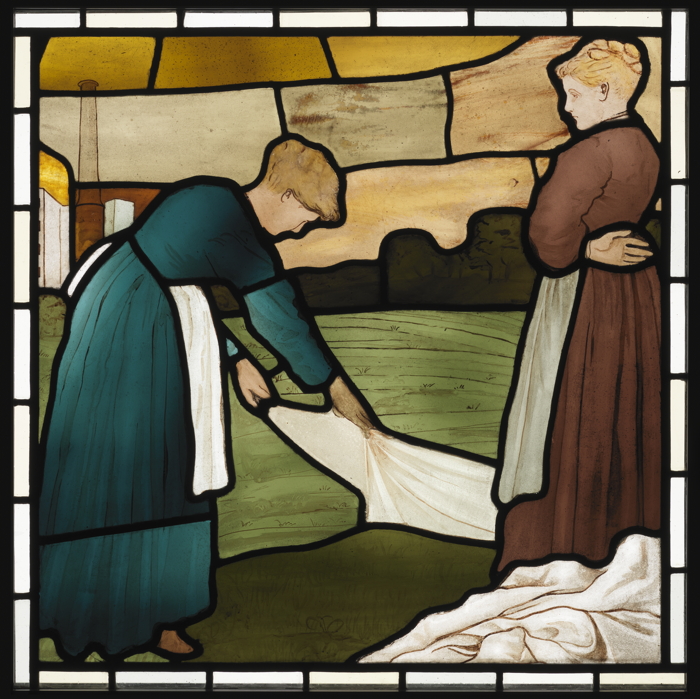
A bleachworks was founded on Maryhill Road (the part then called New City Road) in 1855, but this was within the Glasgow City boundaries, and it engaged in chemical bleaching without bleachfields. There was a linen bleachfield at Dalsholm in the eighteenth century, but this was moved to the Vale of Leven in 1770.
There was only one linen mill of any size in Glasgow by Adam’s time, at St Rollox and it didn’t use bleachfields either. It may have been a cotton bleachfield, for the Kelvindale Mills, but cotton was also bleached chemically by the 1870s. A possibility is that this is an historical image, relating to Maryhill’s pre-1870 past, a lapse from the pattern of the other panels, which show contemporary workplace situations.
The Joiners
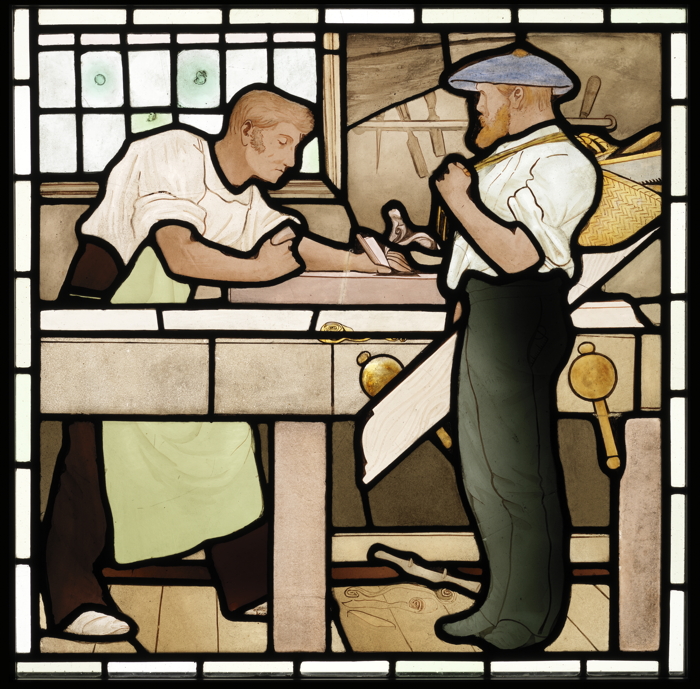
In the nineteenth century skilled woodworkers were designated carpenters, and hads a more general training than those we would now call joiners. This panel illustrates a carpenters’ workshop, of which there would have been more than one in Maryhill then. The only one listed on the P.O. Directory is J & W Goodfellow, cabinetmakers, Main St (now Maryhill Road).
One joiner is at planing a piece of timber on the workbench, while the other is carrying a plank and has a basket of tools slung across his shoulder.
The Iron Moulders
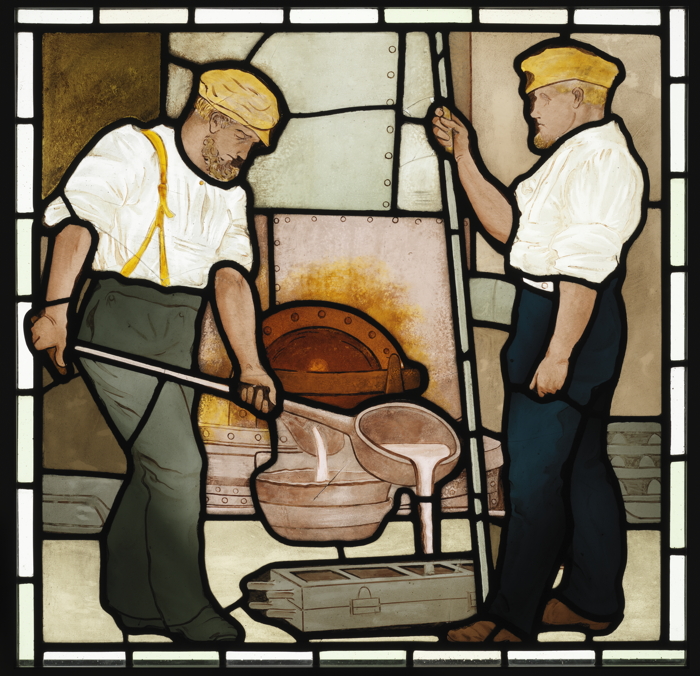
There were a few ironfounders in Maryhill, but as the Caledonia Foundry in Shuna Street dates from the 1890s, this possibly represents Shaw and MacInnes’ Firhill Road ironfounders, dating from 1866.
The firm came from, and brought their workers from, Falkirk – by barge along the canal. The works only closed in 2000, and have been demolished.
The Glassblower
In 1878 Maryhill had two large-scale glass works, both in Murano Street, named after the Murano Glass Works in Venice. The worker is shown with a wide variety of blown glass products. The Caledonia Glass Bottle Works under its owners, Gibson and Scott, were operating since 1874, and it seems likely that this is the location of the panel. The Glasgow Glass Works was also established on the canal banks in 1874, but this produced rolled plate glass and is therefore unlikely to be the location. Both these works had closed by 1973.
This worker is beardless and It is probable that this was because he was still just a boy, as people started work in factories as early as 11 or 12 years old in 1878.
The Gas Worker
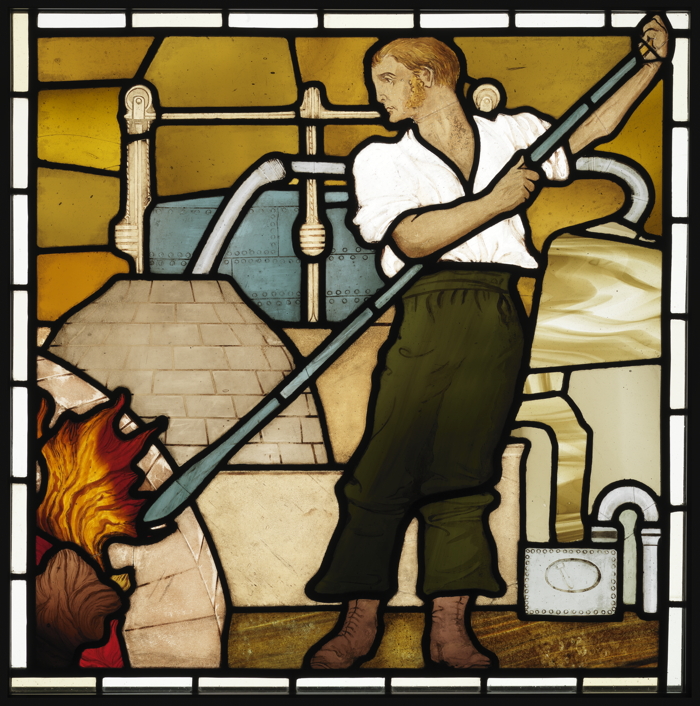
The Dawsholm Gasworks which supplied Maryhill was actually within Glasgow, on the west bank of the Kelvin on Skaethorn Road. It was built by the Glasgow Corporation Gas Department in 1871-2 at the cost of £160,000.
The provision of services like these added fuel to the arguments for the annexation of surrounding burghs by Glasgow. The works was demolished in 1968 and lay long derelict before being developed for housing.
The Engineers
The most likely source of this panel would have been the Maryhill Engine Works at Lochburn Road, built in 1873 for Clarkson Brothers, later Clarkson and Becket. Possibly one of the brothers, John or James, is explaining to the workman with the spanner the requirements of the latest job. The details of the drawing he is holding have sadly faded and been lost.
The building which housed this factory is still standing, and until recently was still in use as an engineering works - the home of Craig & Buchanan since 1926. Recently being renovated and refurbished, it is now a fellow events space.
The Chemical Workers
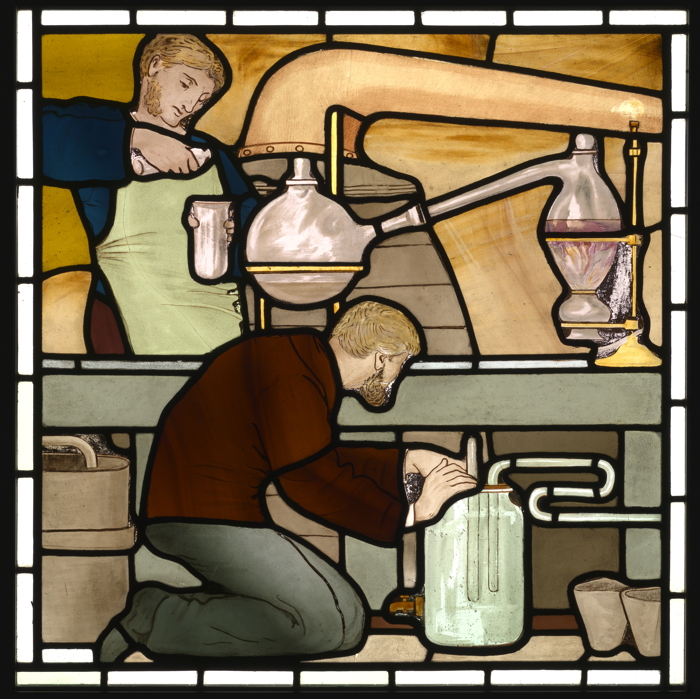
The workers appear engaged in some kind of distillation process. John Sandeman was an oil refiner and rosin distiller at the Ruchill Oil Works in Murano Street, but not till 1883. Of the various chemically related industries in Maryhill, several would have been operative when Adam did his panel. The Glasgow Lead and Colour Works of Alexander Fergusson dates from 1874 and was on both sides of Ruchill Street, with a wharf to the canal. Two years later the Glasgow Rubber Works was built at Shuna Street for George Maclellan and Co., and it made asbestos as well as rubber products.
The latter factory worked into the 1990s, and has recently been flattened for housing. In addition Walls and Co. had a paraffin refinery in Lochburn Road, and this might be the source.
The Canal Boatman
The Canal Boatman is walking along the banks of the canal, his horse pulling a barge, whip in hand. There is a delightful patch sewn onto his knee. Glengarry bonnets were obviously popular with working men in Adam’s time; the series of stained glass shows three.
The boatman is on the aqueduct to the north of the Burgh Halls over Maryhill Road.
The spire is that of Maryhill High Free Kirk (now converted to housing). By the 1870s many of the barges were steam powered. The barges carried bulk goods such as grain, coal and fertiliser.
The Calico Printers
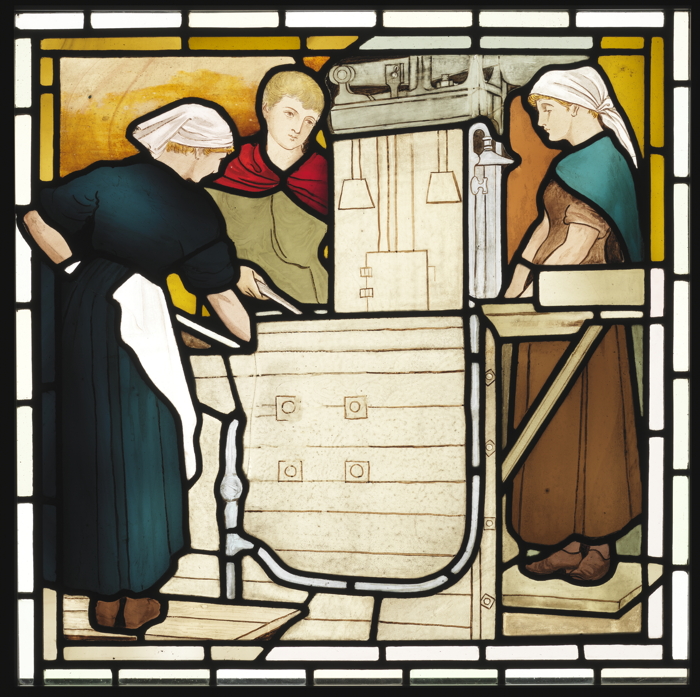
The Bricklayers

The wooden scaffolding, with rope knots, and ladders is interesting. Most of Maryhill was built of stone – the tenements, the barracks, the churches and the civic buildings.
On the other hand many of the factories beside the canal were brick built, and this is probably one of these being constructed.
The Boatbuilder
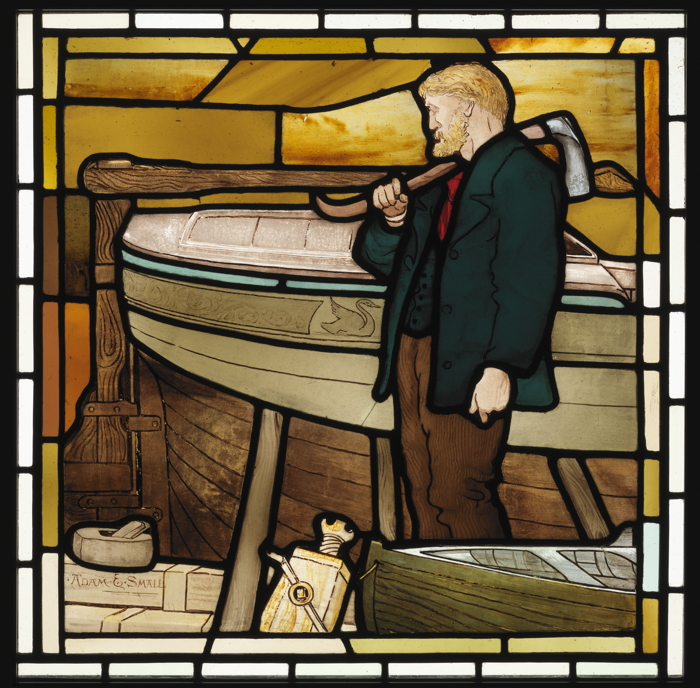
The worker is a ship’s carpenter with his plane (on ground) and a shaping adze over his shoulder. He is wearing corduroy trousers and a jacket and waistcoat –dungarees were a long way off for working men in 1870.
The yard is that at the Kelvin Dock on Maryhill Road, which was actually built as a repair facility for the canal in the 1790s, but later developed as a boat building yard owned by Swan & Co. in the 1850s, and lasting till the 1950s. The boatyard built mainly ironclad puffers, but the vessel shown is a wooden canal barge, with a swan motif. Swan was Maryhill’s first Provost in 1856, and initially lived in a mansion Collina, near the yard.
Notably, this panel features the name of Adam & Small’s company in the lower left.






